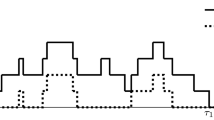Abstract
The notion ofS-modularity was developed by Glasserman and Yao [9] in the context of optimal control of queueing networks.S-modularity allows the objective function to be supermodular in some variables and submodular in others. It models both compatible and conflicting incentives, and hence conveniently accommodates a wide variety of applications. In this paper, we introduceS-modularity into the context ofn-player noncooperative games. This generalizes the well-known supermodular games of Topkis [22], where each player maximizes a supermodular payoff function (or equivalently, minimizes a submodular payoff function). We illustrate the theory through a variety of applications in queueing systems.
Similar content being viewed by others
References
E. Altman, Flow control using the theory of zero sum Markov games, IEEE Trans. Autom. Contr. 39 (1994) 814–818.
E. Altman and A. Hordijk, Zero-sum Markov games and worst-case optimal control of queueing systems, Queueing Systems 21 (1995) 415–447 (this issue).
E. Altman and G. Koole, Stochastic scheduling games with Markov decision arrival processes, Comp. Math. Appl. 26 (1993) 141–148.
J.A. Buzacott and J.G. Shanthikumar, Design of manufacturing systems using queueing models, Queueing Systems 12 (1992) 135–213.
S. Dewan and H. Mendelson, User delay costs and internal pricing for a service facility, Manag. Sci. 36 (1990) 1502–1517.
A. Federgruen and H. Groenevelt, The impact of the composition of the customer base in general queueing models, J. Appl. Prob. 24 (1987) 709–724.
E. Gelenbe and I. Mitrani,Analysis and Synthesis of Computer Systems (Academic Press, New York, 1980).
P. Glasserman and D.D. Yao, Generalized semi-Markov processes: Antimatroid structure and second order properties, Math. Oper. Res. 17 (1992) 444–469.
P. Glasserman and D.D. Yao, Monotone optimal control of permutable GSMP's, Math. Oper. Res. 19 (1994) 449–476.
P. Glasserman and D.D. Yao,Monotone Structure in Discrete-Event Systems (Wiley, New York, 1994).
Y.A. Korilis and A.A. Lazar, Why is flow control hard: Optimality, fairness, partial and delay information, Technical Report, Center for Telecommunications Research, Columbia University, New York, NY 10027 (1992).
Y.A. Korilis and A.A. Lazar, On the existence of equilibria in noncooperative optimal flow control, J. ACM, to appear.
S. Li and T. Basar, Distributed algorithms for the computation of noncooperative equilibria, Automatica 23 (1987) 523–533.
P. Milgrom and J. Roberts, Rationalizability, learning, and equilibrium in games with strategic complementarities, Econometrica 58 (1990) 1255–1277.
J. Nash, Equilibrium points in N-person games, Proc. Nat. Acad. Sci. USA 36 (1950) 48–49.
J. Nash, The bargaining problem, Econometrica 18 (1950) 155–162.
J. Nash, Non-cooperative games, Ann. Math. 54 (1951) 285–295.
J.B. Rosen, Existence and uniqueness of equilibrium points for concave N-person games, Econometrica 33 (1965) 520–534.
J.G. Shanthikumar and D.D. Yao, Multiclass queueing systems: Polymatroidal structure and optimal scheduling control, Oper. Res. 40 (1992) S293-S299.
S. Stidham, Jr., Pricing and capacity decisions for a service facility: Stability and multiple optima, Manag. Sci. 38 (1992) 1121–1139.
D. Topkis, Minimizing a submodular function on a lattice, Oper. Res. 26 (1978) 305–321.
D. Topkis, Equilibrium points in nonzero-sum n-person submodular games, SIAM J. Contr. Optim. 17 (1979) 773–787.
R.R. Weber and S. Stidham, Jr., Optimal control of service rates in networks of queues, Adv. Appl. Prob. 19 (1987) 202–218.
Author information
Authors and Affiliations
Additional information
Supported in part by NSF Grant MSS-92-16490, and by Columbia's Center for Telecommunications Research.
Rights and permissions
About this article
Cite this article
Yao, D.D. S-modular games, with queueing applications. Queueing Syst 21, 449–475 (1995). https://doi.org/10.1007/BF01149170
Received:
Revised:
Issue Date:
DOI: https://doi.org/10.1007/BF01149170




